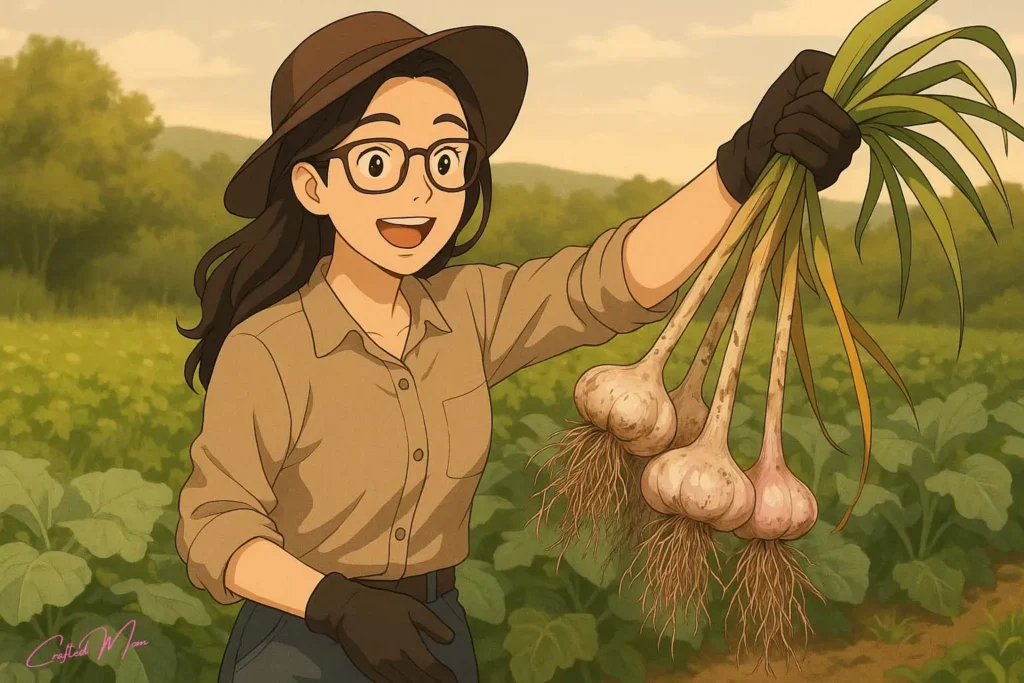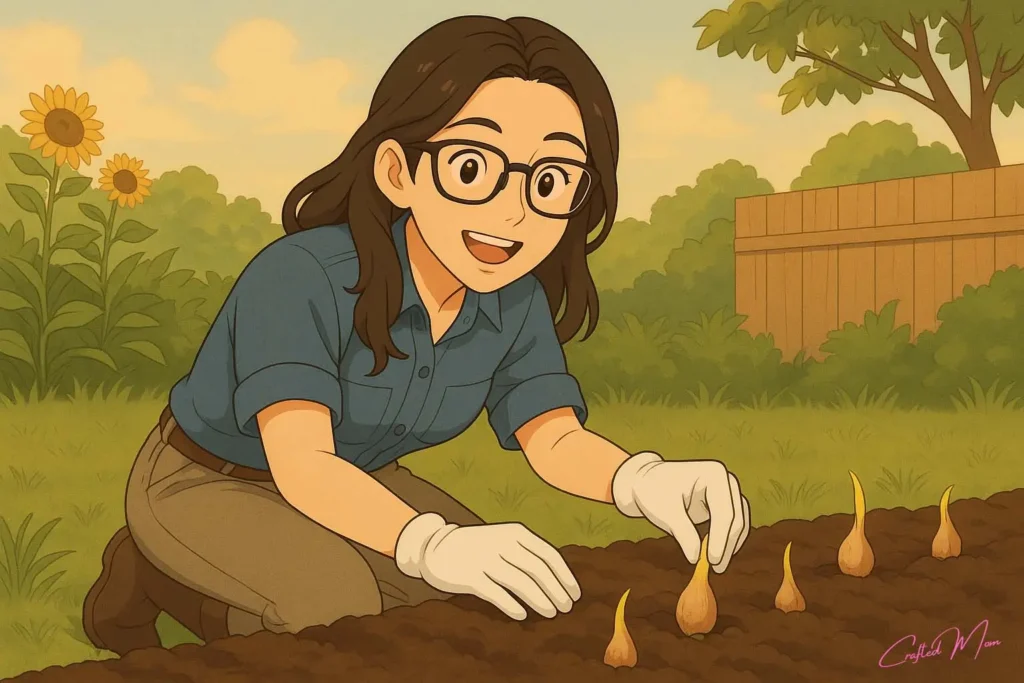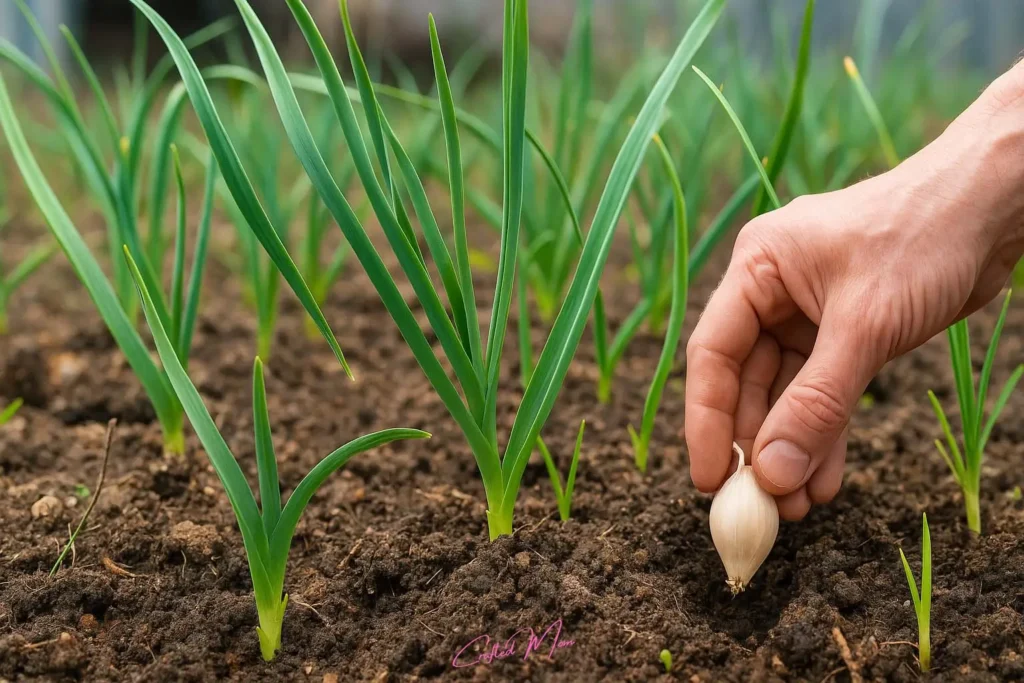If you have ever thought about planting garlic and figured, “How hard can it be?,” you are not alone. Garlic may be a kitchen staple, but growing it? That is where things can get a little tricky for first-timers.
I still remember my first garlic-growing attempt. Let’s just say… I ended up with more questions than cloves. But once you get the hang of it, garlic is one of the most rewarding, and delicious, crops to grow.
Must know before You Plant Garlic

In this guide, I’ll Walk you through everything you need to know before you stick that first clove in the ground. From choosing the right type to knowing when and how to plant, this is your cheat sheet to growing big, bold, flavorful garlic bulbs right in your own backyard. Let’s dig in (literally).
Understanding Garlic Varieties
Before you plant your first clove, it’s important to know with which type of garlic you are working. Trust me, it’s not just a matter of flavor, your climate, storage plans, and taste preferences all come into play.
Softneck Garlic
This is the variety you’re most likely to find at the grocery store, and for good reason.
- It thrives in mild to warm climates
- Bulbs are packed with lots of smaller cloves
- It can store for up to 12 months if cured properly
- The flavor is mild, making it perfect for everyday cooking
- It’s great for braiding, which is a bonus if you’re into rustic kitchen decor
If you live in the South or along the coast, softneck is your go-to.
Hardneck Garlic
Now, if you live somewhere with cold winters, hardneck garlic is your best bet.
- It produces fewer but larger cloves, which are super easy to peel
- Has a stronger, spicier flavor, a favorite among garlic lovers
- Only keeps for about 6–8 months, so plan to use it sooner
- It sends up garlic scapes in spring (which are edible and delicious!)
- Grows best with a proper cold period, known as vernalization
Hardneck might be a little more work, but the flavor payoff? Totally worth it.
Growing Hardneck Garlic in Warm Climates

Love the bold flavor of hardneck garlic but live somewhere warm? Don’t worry, you can still grow it successfully with a little trickery.
Why Hardneck Needs the Cold
Hardneck garlic naturally needs a cold period (called vernalization) to trigger proper bulb formation. In colder climates, winter takes care of that for you. But if you’re gardening in a warm region like the South or coastal zones, you’ll need to mimic Mother Nature.
How to Vernalize Garlic at Home
Here’s how to give your hardneck cloves that chilly nudge they need:
- Refrigerate the cloves (don’t freeze them!) for 8 to 10 weeks
- Place them in a paper bag to prevent moisture buildup
- Store them in your crisper drawer and check weekly for mold or rot
- Don’t peel the cloves, keep them intact until planting day
After their cold nap, they will be ready to go in the ground just like they came from a snowy mountaintop.
Selecting the Right Planting Site

Garlic’s not too picky, but give it the right spot and it’ll reward you with big, beautiful bulbs.
Sunlight Matters
Garlic loves soaking up the sun! Aim for a spot that gets at least 6–8 hours of full sun each day.
- In cooler climates, full sun is non-negotiable
- In hotter regions, a little afternoon shade is totally fine, especially during those scorching summer months
Get That Soil Right
Good garlic starts with great soil.
- Choose loose, well-draining soil, nothing too heavy or soggy
- Avoid clay or compacted areas, which can lead to issues like garlic rust and rot
- Before planting, mix in plenty of compost to boost nutrients and help retain just the right amount of moisture
Think of it like setting a soft, cozy bed for your cloves, roots grow deeper, and bulbs grow bigger.
When to Plant Garlic

Timing is everything when it comes to garlic, and yes, it totally depends on where you live.
Know Your Growing Zone
Before planting, check your USDA growing zone using your ZIP code. That’ll tell you how cold your winters get and help you time your garlic just right.
- Garlic should be planted a few weeks before your ground freezes, that way it has time to establish roots
- In colder zones (like the Northeast or Midwest), that usually means October
- In warmer areas (like San Diego), you can push planting to December or even January
The goal? Let the cloves chill out in the cold for a while. That’s how you get those nice, plump bulbs come harvest time.
How to Plant Garlic Cloves

Alright, you’ve got your cloves and your soil’s ready, now let’s get those babies in the ground the right way.
Step-by-Step Planting Process
- Break apart the garlic bulb: gently, separating the cloves. Keep the papery skins on, those act like natural armor.
- Pick the biggest cloves: for planting. Bigger cloves = bigger bulbs come harvest. It’s science… and a little bit of garden magic.
- Set aside the small ones: they’re great for growing green garlic, which is kind of like a garlicky scallion (delicious in stir-fries, by the way).
- Plant each clove pointy side up: (flat root side down) about 3–4 inches deep and 6 inches apart.
Give them space, they hate being crowded.
Once they’re tucked in, give the bed a good watering and maybe a little mulch blanket. You’re officially growing garlic!
Spacing and Layout
Garlic likes a little elbow room, too close, and you’ll get puny bulbs and a higher chance of disease.
- Space each clove about 6 inches apart in the row
- Leave 6 to 8 inches between rows, especially if you’re in a humid climate or using raised beds
- Good spacing helps with airflow, which keeps fungal diseases like garlic rust and white rot at bay
- Plus, less competition = bigger, healthier bulbs
Think of it as giving each plant its own personal bubble, it makes a world of difference!
Mulching and Maintenance

Mulch is garlic’s best friend, especially in warmer or unpredictable climates.
- After planting, cover your garlic bed with about 3 inches of light-colored mulch, garden straw works perfectly
- Mulch helps keep the soil moist, cool, and protects those baby cloves from sudden temperature swings
- It also blocks weeds (less work for you!) and prevents early heat exposure, which can mess with bulb development
Just keep an eye on moisture. If things get soggy under the mulch, pull it back a bit to let the soil breathe.
Final Tips for Garlic Success

You’ve planted, mulched, and spaced everything just right, now let’s make sure your garlic thrives from start to finish.
- Keep weeds under control: garlic hates competition, and even a few weeds can stunt bulb growth
- Feed your soil, not just your plants: a good dose of compost or organic fertilizer can do wonders throughout the growing season
- In early spring: start checking for green shoots. That’s your garlic waking up! Adjust watering and care as needed from there
Growing garlic is a bit of a waiting game, but it’s so worth it. With just a little TLC, you’ll be pulling up beautiful, flavorful bulbs before you know it.
What’s Next?
You’ve got garlic in the ground, now what?
- Once those green shoots pop up in early spring, your garlic will need some targeted care to grow big, hearty bulbs
- Think watering adjustments, feeding, and knowing when (and how) to stop watering before harvest
Final Thoughts:
Garlic is one of the easiest and most rewarding crops you can grow, if you know what you’re doing from the start. In this guide, we covered everything you must know before planting garlic, from choosing between softneck and hardneck varieties to prepping your soil, spacing cloves, mulching, and keeping weeds at bay. We even touched on how to grow hardneck garlic in warm climates (hint: your fridge is involved) and what to expect once those little green shoots appear in spring.
Whether you’re a backyard gardener or growing garlic in raised beds on a balcony, a little planning goes a long way. The result? Bold, flavorful bulbs that’ll make every dish shine. And if you’re looking to maximize your garden’s yield, don’t miss out on learning How to Ripen Green Tomatoes In Just 7 Days for even more fresh produce right from your own backyard.
Have you grown garlic before? Or are you trying it for the first time this season? Share your garlic-growing journey in the comments, we’d love to hear how it’s going and what’s worked best for you!
Frequently Asked Questions:
When is the best time to plant garlic?
Fall is the optimal time to plant garlic, typically 4–6 weeks before the ground freezes. This allows cloves to establish roots before winter dormancy. In milder climates, planting can extend into late winter or early spring, though bulbs may be smaller.
Can I plant garlic from the grocery store?
It’s not recommended. Store-bought garlic is often treated with growth inhibitors to prevent sprouting and may carry diseases. For best results, use certified seed garlic from reputable suppliers or local farmers’ markets.
What type of garlic should I plant, hardneck or softneck?
Hardneck: Suited for colder climates, produces scapes (edible flower stalks), and offers complex flavors.
Softneck: Thrives in warmer regions, has a longer shelf life, and is commonly found in supermarkets.

